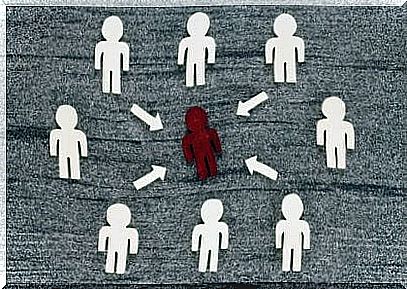Persuasion Techniques To Change Attitudes

Social psychology has for years studied the various persuasive techniques that we can use to promote behavior change and induce people to behave in specific ways.
These studies are not only intended to help create compelling advertising campaigns; it is also about fostering behavior change that involves adopting new, healthy and appropriate attitudes.
Eagle and Chaikin define the concept of attitude as “a psychological tendency which involves the evaluation of an object to determine whether it is favorable or unfavorable”.
When it comes to attitude, the valence (positive or negative character of the attribution made of an object) as well as its intensity (the degree of intensity of the valence in question) are aspects to be taken into consideration.
Usually, an attitude can be positive or negative. But it is also possible that it seems neutral to us or is indifferent to us.
For Rosenberg and Hovland, attitude contains three components: affective components (satisfaction or dissatisfaction, taste or disgust for something), cognitive components (beliefs, opinions and ideas) and cognitive-behavioral components (behavioral intentions or orientation of actions).
Social psychology has developed various techniques or strategies aimed at promoting changes in attitude. More concretely, we will focus here on socially mediated strategies.
There are several key variables in the persuasion process aimed at achieving attitude change, such as:
- the credibility of the source
- the attraction
- the use of a rational and emotional message
- the use of examples
But there are also some techniques specially designed to influence the behavior of individuals. Let’s discover them together in the rest of this article.
Persuasion techniques based on friendship or satisfaction

Attracting the sympathy of the other is one of the techniques of persuasion
This technique involves pleasing others so that they are more willing to meet our expectations.
When we see the other as attractive, just because of the Halo effect, we think what they have to offer will also be appealing.
Here is an example: choosing young men and young women who are physically attractive for a position that involves contact with people (working in a nightclub for example).
Here is another example: a restaurant chef who is particularly courteous in order to attract more customers.
Self-promotion
This technique involves improving our physical appearance, emitting positive verbal cues (smiles, looking straight in the eye) and associating with facts or people that appeal to our target audience.
Here is an example: a bookseller who invites a trendy writer to give a talk in his bookstore so that people come to see him and, perhaps in the process, buy books in the store.
The promotion
This persuasion strategy is centered on others.
It is all about flattering and agreeing with your target audience. Gifts are another tool.
Persuasion techniques based on commitment and consistency
One foot in front of the door
This technique consists of having a small initial proposition accepted in order to increase the probability that the target will accept another larger future proposition.
Take the example of distributing perfume samples so that the target audience feels indebted and ends up buying the perfume in question.
Priming or law-balling
This technique consists of inducing an individual to make a decision while temporarily concealing certain conditions.
The individual in question receives a very interesting proposition which he then accepts. Once the proposal is accepted, something unexpected arises and the terms of the agreement change. It is ultimately the person making the offer who benefits most from the agreement.
We offer you a scenario … You receive an offer for a pack that includes a computer, a computer manual, a mouse and word processing software. Finally, you are told that the software is not included. It is likely that you will make the purchase anyway, because you had already prepared for this idea.
The lure technique
In this case, a product is presented at a very good price, which is why you decide to buy it. Once the decision has been made, as luck would have it, the stock is exhausted or the product is of poor quality.
Our predisposition to make a purchase in question means that we will want to replace this product with another even if it is not exactly the product we were looking for. So it is likely that you are looking to buy a similar product and the seller will point you in that direction.
Persuasion techniques based on reciprocity
Door slam in the face
This technique consists in starting by making an overly important proposition which, logically, will be rejected. Once rejected, the person behind the proposal proposes a new one, this time smaller, the one that really interested him.
Here is a scenario … You ask for an increase that doubles your salary, and when your boss, logically, says no, you propose a much more plausible increase. It is very likely that your boss accepts, by reciprocity.
That’s not all
An initial offer is made, but before the person accepts or rejects the offer, a new element arises that makes the offer even more attractive.
Here is a scenario … A telephone company calls you: it offers you not only a more interesting telephone contract, but also a landline telephone.
A tap on the shoulder
This technique involves establishing a relationship with the target person so that they feel obligated to accept the proposals.
Persuasion techniques based on scarcity

Emphasize scarcity
It is a question here of insinuating that an object is rare or difficult to acquire in order to make the object in question more attractive and thus to increase the probability that the target person accepts.
This technique reminds us of sentimental relationships : the more difficult a person is to conquer, the more attractive they seem to us.
Deadline
This technique consists of setting a deadline for acquiring a product. Once this period has passed, the product in question will no longer be available.
Other persuasion techniques
- Arouse curiosity: capture the attention of the target audience to avoid immediate rejection.
- Do everything possible to keep the other in a good mood: flatter the other so that they feel good and thus reduce the likelihood that they will refuse a request.
- Complain : express dissatisfaction in order to make others aware of your complaint.
In short …
We are continually bombarded with persuasive techniques from our social environment.
Within our system, changing the behavior of the population is an objective to be achieved, as much by means of communication as by politics or advertising.
Knowing about these different persuasion techniques that aim to change our attitudes is important. This allows us to understand how the media tries to convince us to adopt specific behavior that was not natural to us or that we would not have thought of. Knowing this allows us to avoid falling into the trap.
It is important to realize that most of the things we own and most of the things we do do not meet real needs. It is the weight of social influence that takes precedence over our own will.
With this knowledge, you will be able to be more responsible when making decisions.










